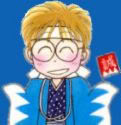
Kaze Hikaru is a shojo manga seires by Watanabe Taeko that began in 1997 – originally in Betsucomi, and was later moved to the slightly older skewing Flowers. It won the Shogakukan Manga Award in the Girls’ Category in 2003, sharing the award with NANA. The series is still running as of 2011, and recently released the 30th volume.
In the US, it was one of the six inaugural titles in the shojo manga anthology magazine, Shojo Beat in 2005, and ran for a little over a year before being cycled out for Backstage Prince. It is also licensed in Indonesia, Vietnam, South Korea and Taiwan.
The series starts with a young girl in disguise joining a group of ronin that have gathered in Mibu, a village of Kyoto, and follows the Shinsengumi through history, always seen through the eyes of Sei. Will she be able to remain in the Shinsengumi? Will she have to become a “demon” in order to wield a sword? Almost ten years into the series, her full story has yet to be told.
The title comes from a haiku, and literally means “Shining Wind”

Watanabe Taeko (辺 多恵子) was born on August 29th, 1960 in the Tokyo area. Her blood type is AB. She recently celebrated 30 years of working in manga.
Her first work, “Waka-chan no Netsuai Jidai”, was published in Bessatu Shoujo Comic. Since the early 80’s she’s been a known and prolific mangaka, her long-running series include:
– Family: The Andersons are a perfect California family, and all is going well… until a little boy shows up, claiming to be the illegitimate son of Mr. Anderson! Later stories include the addition of a Japanese exchange student to the mix.
– Hajime-chan ga Ichiban! : Hajime’s younger siblings are quintuplets, and end up on TV. This series won the Shogakukan Manga Award in the Girls’ category in 1991.
– Numerous one-shot stories done over the years.
According to a free talk in the first volume of Kaze Hikaru, she was inspired to do KH after seeing a friend in a play about the Shinsengumi. Since then she’s done a lot of research, reading hundreds of historical sources on the characters and the world they lived in. Her free talks later develop